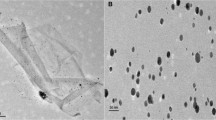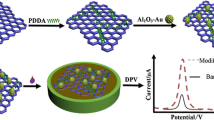Abstract
A highly sensitive and selective sensor is fabricated based on graphene/titanium dioxide/polyaniline modified glassy carbon electrode (GRP/TiO2/PANI/GCE). It is demonstrated that this sensor can be used for determination of a pharmaceutically important compound aripiprazole (ARP) using square wave voltammetry and cyclic voltammetry (SWV & CV). Scanning electron microscope (SEM) was used to investigate the assembly process of the nanocomposite modifier. The electrochemical investigation of ARP at (GRP/TiO2/PANI/GCE) was found to be the function of pH of the supporting electrolyte, and variation in scan rate and concentration. Electro-oxidation of ARP showed irreversible and adsorption-controlled behaviour at GRP/TiO2/PANI/GCE. Charge transfer coefficient and number of electrons and protons involved in the electrode mechanism were calculated. SWV of different concentrations of ARP showed a linear dynamic range from 5 to 40 ng/mL with the detection limit of 0.99 ng/mL. The analytical performance of this sensor has been evaluated for the detection of ARP in pharmaceutical formulation with satisfactory results.











Similar content being viewed by others
References
De-Leon A, Patel NC, Crismon ML (2004) Aripiprazole: a comprehensive review of its pharmacology, clinical efficacy and tolerability. Clin Ther 26:649–666
Liberman JA (2004) Dopamine partial agonist: a new class of antipsychotic. CNS Drugs 18:251–267
Mallikarjun S, Salazar DE, Bramer SL (2007) Pharmacokinetics, tolerability and safety of aripiprazole following multiple oral dosing in normal healthy volunteers. J Clin Pharmacol 44:179–187
Shinokawa Y, Akiyama H et al (2005) High performance liquid chromatography methods for the determination of aripiprazole with ultraviolet detection in rat plasma and brain: application to the pharmokinetic study. J Chromatogr B 821:8–14
Kircherr H, Kuhn-Welten WN (2006) Quantitative determination of forty-eight antidepressants and antipsychotics In human serum by HPLC tandem mass spectrometry: a multilevel single-sample approach. J. Chromatogr B 843:100–113
Li KY, Zho YG et al (2007) Ultra-performance liquid chromatography tandem mass spectrometry for the determination of atypical anti-psychotics and some metabolites in in-vitro samples. J Chromatogr B 850:581–585
Kubo M, Mizzoku Y et al (2005) Development and validation of an LC-MS/MS method for the quantitative determination of aripiprazole and its main metabolite, OPC-14857 in human blood plasma. J Chromatogr B 822:294–299
Song M, Xu X et al (2009) Development of an LC-MS/MS method for the simultaneous quantification of aripiprazole and dehydroaripiprazole in human plasma. Anal Biochem 385:270–277
Asangil D, Tasdemir IH, Kilic E (2012) Adsorptive stripping voltammetric methods for the determination of aripiprazole. J Pharmaceut Anal 2:193–199
Meli D, Dondi D, Ravelli D, Tacchini D, Profuma A (2013) Electrochemistry and analytical determination of aripiprazole and octoclothepin at glassy carbon electrode. J Electroanal Chem 711:1–7
Jain R, Jadon N, Radhapyari K (2006) Determination of antihelminthic drug pyrantel pamoate in bulk and pharmaceutical formulations using electroanalytical methods. Talanta 70:383–386
Jain R, Yadav V (2011) Voltammetric determination of cefpirome at multiwalled carbon nanotube modified glassy carbon electrode baed sensor in bulk form and pharmaceutical formulation. Colloid Surf B: Biointerfaces 87:423–426
Kang X, Jun W, Hong W et al (2010) A graphene based electrochemical sensor for sensitive detection of paracetamol. Talanta 81:754–759
Jain R, Diwedi A, Mishra R (2009) Adsorptive stripping voltammetric behaviour of nortriptyline hydrochloride and its determination in surfactant media. Langmuir 25:10364–10369
Goyal RN, Gupta VK, Chatergee S (2009) Fullerene-C60-modified edge plane pyrolytic graphite electrode for the determination of dexamethasone in pharmaceutical formulations and human biological fluids. Biosens Bioelectron 24:1649–1654
Goyal RN, Gupta VK, Bachheti N, Fullerene C60-modified electrode as a sensitive voltammetric sensor for detection of nandrolon, an anabolic steroid used in doping. Analyt. Chim. Acta. 597: 82–89
Salinii A, Hallaj R (2012) Cobalt Oxide nanostructure modified glassy carbon electrode as a highly sensitive flow injection amperometric sensor for the picomolar detection of insulin. J Sol Stat Electrochem 16:1239–1246
Kalanur SS, Jaldappagari S, Balakrishnan S (2011) Enhanced electrochemical response of carbamazepine at a nano-structured sensing film of fullerene-C60 and its analytical applications 56: 5295–5301
Ratinac KR, Yang W et al (2011) Graphene and related materials in electrochemical sensing. Electroanalysis 23:803–826
Liu YX, Dong XC, Chen P (2012) Biological and chemicals sensors based on graphene materials. Chem Soc Rev 41:2283–2307
Zhang YB, Tan YW et al (2005) Experimental observation of the quantum hall effect and Berry’s Phase in graphene. Nature 438:201–204
Balandin AA, Ghosh S et al (2008) Superior thermal conductivity of single layer graphene. Nano Lett 8:902–907
Gomez-Navarro C, Burghard M, Kern K (2008) Elastic properties of chemically derived single layer graphene sheets. Nano Lett 8:2045–2049
Stoller MD, Park S et al (2008) Graphene based ultracapacitors. Nano Lett 8:3498–3502
Lian W, Liu S et al (2012) Electrochemical sensor based on gold nanoparticles fabricated molecularly imprinted polymer film at chitosan/platinum nanoparticles/graphene-Au nanoparticles double nanocomposite modified electrode for the detection of erythromycin. Biosens Bioelectron 38:163–169
Ye D, Luo L et al (2011) A novel nitrite sensor based on graphene/polypyrolle/chitosan nanocomposite modified glassy carbon electrode. Analyst 136:1563–1569
Basanayak PA, Ram MK et al (2013) Graphene/polypyrolle nanocomposite as electrochemical super capacitor electrode: electrochemical impedance studies. Sci Res 2:81–87
Wu C, Huang X et al (2013) Highly conductive nanocomposites with three dimensional compactly interconnected graphene networks via a self-assembly process. Adv Funct Mater 23:506–513
Fan H, Wang L et al (2010) Fabrication, mechanical properties and biocompatibility of graphene-reinforced chitosan composites. Biomacromol 11:2345–2351
Shih Y-T, Lee K-Y, Huang Y-S (2014) Electrochemical capacitance characteristics of patterned ruthenium dioxide-carbon nanotube nanocomposites grown onto graphene. Appl Surf Sci 294:29–35
Muszynski R, Seger B, Kanat (2010) Decorating enhanced photoresponse of reduced graphene oxide. ACS Nano 4:3033–3038
Geng X, Niu L, Xing Z et al (2010) Aqueous processable noncovalent chemically converted graphene quantum dot composite for flexible and transparent opto electronic films. Adv Mater 22:638–642
Cao A, Liu Z, Chu S et al (2010) A facile one step method to produce graphene-Cds quantum dot nanocomposites as promising opto electronic materials. Adv Mater 22:103–106
Xu J, Wang K, Zu S-Z et al (2010) Hiearchial nanocomposite of polyaniline nanowire arrays on graphene oxide sheets with synergistic effect for energy storage. ACS Nano 4:5019–5026
Lin Y, Zhang K, Chen W et al (2010) Dramatically enhanced photoresponse of reduced graphene oxide. ACS Nano 4:3033–3038
Wang F, Wang W, Liu B et al (2009) Copolypeptide-doped polyaniline nanofibres for electrochemical detection of ultratrace trinitrotoluene. Talanta 79:376–382
Khan R, Solanki PR et al (2009) Cholesterol biosensor based on electrochemicall prepared polyaniline conducting polymer film in presence of non-ionic surfactant. J Polym Res 16:363–373
Tiwari DC, Jain R, Sharma S (2008) Spectroscopic and thermogravimetric analysis of PANI/ PPY composite polymer electrode: its application to electrochemical investigation of pharmaceutical formulation. J Appl Polym Sci 110:2328–2336
Jia Q, Shan S, Jiang L, Wang Y (2010) One step synthesis of polyaniline nanofibres decorated with silver. J Appl Polym Sci 115:26–31
Zhang J, Zheng Y et al (2008) Electrocatalytic evaluation of liquid phase deposited methylene blue/TiO2 hybrid films. Electrochem Commun 10:1038–1040
Xu C-X, Huang K-J et al (2012) Electrochemical determination of acetaminophen based on TiO2-graphene/poly (methyl red) composite film modified electrode. J Mol Liq 10:1038–1040
Kumaravel A, Chandrashekaran M (2011) Electrochemical determination of imidacloprid using nanosilver nafion/ nano TiO2 nafion compositemodified glassy carbon electrode. Sens Actuators B: Chem 158:319–326
Yang L, Yang W, Cai Q (2007) Well-dispersed Pt Au nanoparticles loaded into anodic titania nanotubes: a high antipoison and stable catalyst system for methanol oxidation in alkaline media. J Phys Chem 111:16613–16617
Rella R, Spadavecchia J et al (2007) Acetone and ethanol solid-state gas sensors based on TiO2 nanoparticles thin film deposited by matrix assisted pulsed laser evaporation. Sens Actuator B: Chem 127:426–431
Lin W-J, Hsu C-T, Tsai Y-C (2011) Dyesensitized solar cells based on multiwalled carbon nanotube-titania/ titania bilayer structure photoelectrode. J Colloid Interface Sci 358:562–566
Wang J, Zhao R, Xu M, Cheng G (2010) Cathodic electrochemiluminescence of luminol in aqueous solutions based on C-doped oxide covered titanium electrode. Electrochim Acta 56:74–79
Kwon Y, Kim M et al (2012) Enhanced ethanol sensing properties of TiO2 nanotube sensors. Sens Actuator B: Chem 173:441–446
Fan Y, Liu J, Lu H, Zhang Q (2011) Electrochemical behaviour and voltammetric determination of paracetamol at nafion/TiO2-graphene modified glassy carbon electrode. Coll Surf B: Biointerfaces 85:289–292
Sun J, Huang K et al (2011) Direct electrochemistry and electrocatalysis of haemoglobin on chitosan-room temperature ionic liquid-TiO2-graphene nanocomposite film modified electrode. Bioelectrochemistry 82:125–130
Benvenuto P, Kafi AKM, Chen A (2009) High performance glucose biosensor based on the immobilization of glucose oxidase onto modified titania nanotube. J Electroanal Chem 627:76–81
Fan Y, Lu H-T et al (2011) Hydrothermal preparation and electrochemical sensing properties of TiO2-graphene nanocomposite colloids surf. B: Biointerfaces 83:78–82
Ghosh D, Giri S, Kalra S, Das CK (2012) Synthesis and characterization of TiO2 coated multiwalled carbon nanotubes/graphene/polyaniline nanocomposite for super capacitor applications 2: 70–77
ᅟ
Abdolahi A, Hazah E et al (2012) Synthesis of uniform polyaniline nanofibres through interfacial polymerization. Mater 5:1487–1494
Filipiak M (2001) Electrochemical analysis of poly phenolic compunds. Anal Sci 17:1667–1670
Dar RA, Brahman PK et al (2011) Adsorptive stripping voltammetric determination of podophyllotoxin, an antitumour herbal drug, at multi-walled carbon nanotube paste electrode. J Appl Electrochem 41:1311–1321
Xing T-L, Fe W et al (2009) Electrochemical behaviour of apigenin at a glassy carbon electrode and its analytical application. J Chin Chem Soc 56:303–309
Hedge RN, Swamy BEK, Sherigara BS, Nandibewoor ST (2008) Electrooxidation of atenolol at a glassy carbon electrode. Int J Electrochem Sci 3:302–314
Goyal RN, Gupta VK, Oyama M, Bachheti N (2006) Differential pulse voltammetric determination of atenolol in pharmaceutical formulations and urine using nanogold modified indium tin oxide electrode. Electrochem Commun 8(1):65–70
Brown ER, Large RF, In: Weissberger A, Rossiter BW (eds) (1964) Physical methods of chemistry. Wiley Interscience Rochester p423
Bard AJ, Faulkner LR (1980) Electroahemical methods, fundamentals and applications. Wiley, New York, p 522
Liu J-X, Wu YJ et al (2008) Adsorptive voltammetric behaviour of resveratrol at graphite electrode and its determination in tablet dosage form. J Chin Chem Soc 55:264–270
Scholz F (2002) Electroanalytical methods. Springer, Verlag, pp 78–319
Erk N, Voltammetric behaviour and determination of moxifloxacin in pharmaceutical products and human plasma. Anal Bioanal Chem 378:1351–1356
Acknowledgments
Authors acknowledge the central facility, department of Indian Institute of Technology, New Delhi, India, for carrying out SEM characterization. They are thankful to the UGC-BSR for the fellowship to two of the authors (Ratnanjali Shrivastava and Sachin Saxena).
Author information
Authors and Affiliations
Corresponding author
Rights and permissions
About this article
Cite this article
Shrivastava, R., Saxena, S., Satsangee, S.P. et al. Graphene/TiO2/polyaniline nanocomposite based sensor for the electrochemical investigation of aripiprazole in pharmaceutical formulation. Ionics 21, 2039–2049 (2015). https://doi.org/10.1007/s11581-014-1353-3
Received:
Revised:
Accepted:
Published:
Issue Date:
DOI: https://doi.org/10.1007/s11581-014-1353-3




